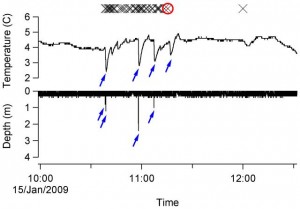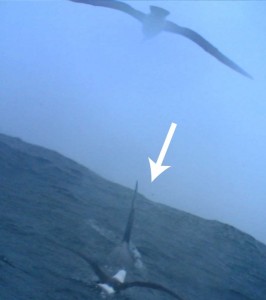Tiny Cameras Show Albatrosses on the Hunt
/https://tf-cmsv2-smithsonianmag-media.s3.amazonaws.com/filer/20110520102257albatross_flight-300x209.jpg)
Scientists from Britain and Japan used sophisticated techniques to study the feeding behavior of the black-browed albatross (Thalassarche melanophrys) at sea. A lot of useful information came out of this study, but the single item you will likely hear most about is a really cool photograph, taken by the albatross itself, of a killer whale.
It is difficult to study albatross because they fly hundreds of kilometers across open ocean, flying faster than a boat can sail, to find food. Since you can't just follow them, and since their open ocean feeding area is very large, observing albatross feeding behavior can't be done reliably.
The new study addressed this problem by using miniature digital cameras attached to the backs of four birds breeding at colonies on Bird Island, South Georgia in the Southern Ocean. The resulting pictures showed albatrosses foraging in groups while at sea to collect food for their chicks. The cameras included a depth meter and a thermometer. The depth information was intended to indicate when the albatross would dive underwater for food, and the temperature meter indicates when the bird is settled on the sea surface or dives into water.
The following diagram shows what these information resulting from an instrument-fitted albatross flight looks like:

The X-axis is time, showing that this particular flight that took over two hours. The squiggly line along the top indicates temperature and the vertical lines along the lower part of the chart indicate depth. The bird appears to make four dives and later on sits on the water for a while (indicated by the cooling down without a dive event). The camera took photographs on a regular basis, and the Xes in the diagram indicate a photograph with another organism in it, generally another albatross. This shows that the albatross tracked in this diagram dived and presumably fed in the vicinity of other birds. The X with the red circle indicates a photograph of special interest, this one:

Here you can see two birds, one higher and one lower than the bird with the camera, and the three birds together seem to be closing in on a whale. This is an orca, a.k.a. killer whale.
This image showed that the killer whale broke the surface and that three other albatrosses were also apparently following the whale. This image was, unfortunately, followed by subsequent images that were obscured by feathers. However, the rapidly decreasing external temperature suggests that the bird landed on the sea surface after the encounter with the killer whale...
The camera is small, weighing about 82 grams. Although the camera slightly changes the aerodynamic shape of the albatross, it did not affect the breeding success of the study birds. In all, over 28,000 pictures were taken with the albatross mounted cameras. According to Dr Richard Phillips from British Antarctic Survey (BAS), "These images are really interesting. They show us that albatrosses associate with marine mammals in the same way as tropical seabirds often do with tuna. In both cases the prey (usually fish) are directed to the surface and then it's easy hunting for the birds."
/https://tf-cmsv2-smithsonianmag-media.s3.amazonaws.com/accounts/headshot/greg-laden-240.jpg)
/https://tf-cmsv2-smithsonianmag-media.s3.amazonaws.com/accounts/headshot/greg-laden-240.jpg)